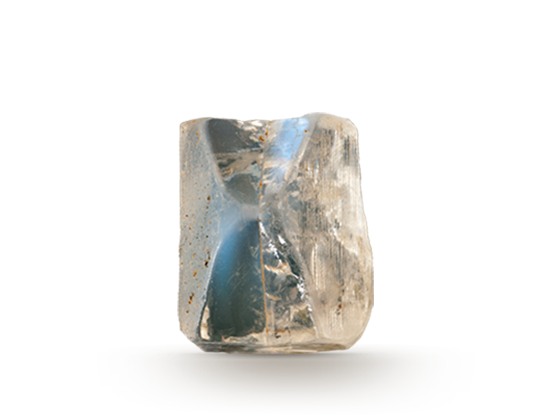OVERVIEW
Moonstone is a variety of the feldspar-group mineral orthoclase. During formation, orthoclase and albite separate into alternating layers. When light falls between these thin layers it is scattered producing the phenomenon called adularescence. Adularescence is the light that appears to billow across a gem. Other feldspar minerals can also show adularescence including labradorite and sanidine.
Moonstone’s delicate beauty and its long-established heritage make it perhaps the most familiar gem-quality member of the feldspar group.
Feldspars are the most widespread minerals in the earth’s crust, as well as some of the most diverse. You can pick up a rock anywhere in the world, and you’ll probably find that it contains a mineral or two from the feldspar group.
Moonstone is a variety of the feldspar-group mineral orthoclase. It’s composed of two feldspar minerals, orthoclase and albite. At first, the two minerals are intermingled. Then, as the newly formed mineral cools, the intergrown orthoclase and albite separate into stacked, alternating layers.
- Mineral: Feldspar
- Chemistry: KAlSi3O8
- Color: Colorless to White, Gray, Green, Peach, Brown
- Refractive index: 1.518 to 1.526
- Birefringence: 0.05 to 0.008
- Specific gravity: 2.58
- Mohs Hardness: 6.0 to 6.5
WHERE IS IT FOUND ?
Moonstone can be found in a wide variety of places. This includes parts of the United States, such as New Mexico, North Carolina and Virginia. The most important world locations for the moonstone birthstone are India and Sri Lanka, but sources also include Brazil, India, Sri Lanka, Madagascar, Myanmar and Tanzania.
CARE & CLEANING
Moonstone is a 6–6.5 on the Mohs scale of hardness and has poor toughness. It may crack when exposed to high heat. Therefore, ultrasonic and steam cleaners should not be used on your moonstone. The best option for cleaning is warm, soapy water with a soft brush.
BIRTHSTONE
Moonstone is a birthstone for June, along with pearl and alexandrite.
HISTORY
Moonstone’s mysterious, billowy, glow has fascinated people for centuries.
According to Hindu mythology, moonstone is made of solidified moonbeams. Many other cultures also associate this gem with moonlight, and it’s easy to see why. Its internal structure scatters the light that strikes it, creating a phenomenon known as adularescence. The visual effect is reminiscent of the full moon shining through a veil of thin, high clouds.
Legends say that moonstone brings good luck. Many believed that you could see the future if you held a moonstone in your mouth during a full moon.
Adularescent moonstone was once called “adularia.” The name originated with a city in Switzerland, Mt. Adular (now St. Gotthard), that was one of the first sources of fine-quality moonstone.
Great designers of the romantic Art Nouveau era, such as René Lalique and Louis Comfort Tiffany, featured the pale gem in custom jewelry. Moonstone was also a favorite among artisans of the Arts and Crafts era in the last half of the nineteenth century, who used it in handcrafted silver items.
During the 1960s “flower child” movement, moonstone provided its wearers with the desired ethereal look, and designers of the 1990s New Age movement again turned to moonstone’s natural beauty for inspiration.
Source of Content : www.gia.edu


